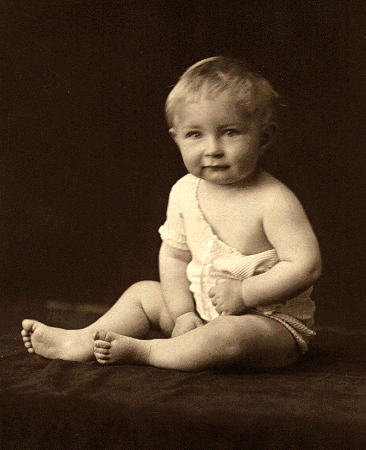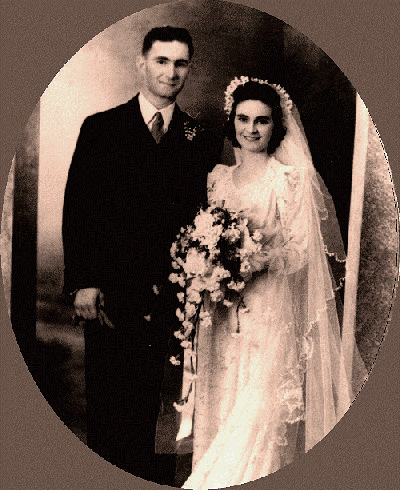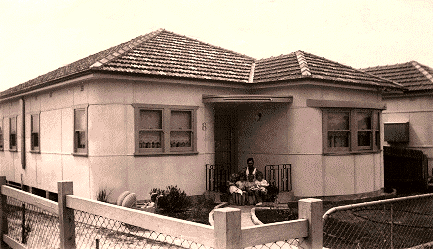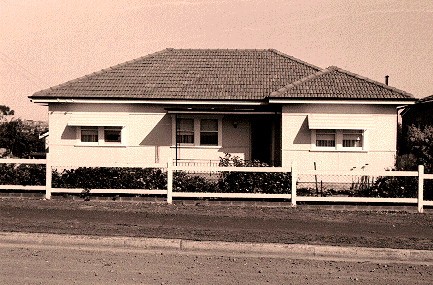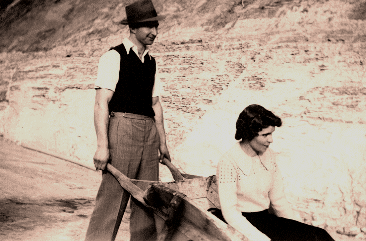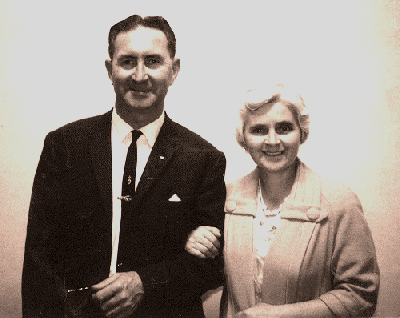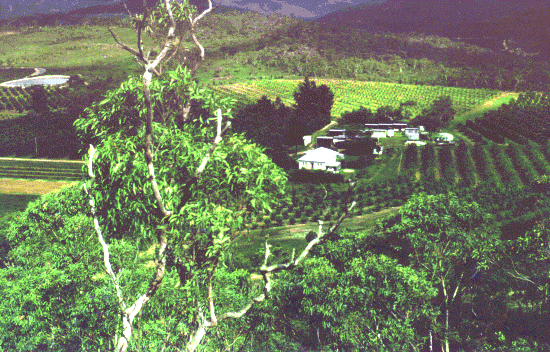 |
|||||||||||||||
As well as myself, there was Kenneth Charles (b. 13 May 1916), Russell Frederick (b. 22 March 1923), and Norman Henry (b. 9 July 1924). We lived as a family in Croydon, Sydney, in a cottage owned by my grandmother. Brother Ken and I attended the Croydon Public School. I never liked school, because I found study hard, and consequently learned slowly. My mother and father had a new home built at Bexley into which we moved in 1925. It was a lovely brick home which we all appreciated very much. My mother and father lived out their lives in this lovely old home. Dad would spend all day Saturday mowing, cutting along paths with a big carving knife; the garden edges were done with a straight edge and shears! Sometimes I would help him, and other times it all fell to me as he would be working away. Perhaps this is when I gained my love of gardening. As kids we had to make our own fun, as there was no such thing as television and fun parlours. We would spend hours making and flying kites in the paddock opposite our house. Other times we would play cricket or football, have paper chases that would lead through gullies covered in blackberry bushes, and anywhere to make it more difficult and entertaining. Bexley Gully was a favourite haunt with us kids, as the wildflowers in the spring and the birds were beautiful, especially the whip-coach birds with their shrill calls. Unfortunately, as the houses and roads went in, the birds moved on. Another haunt was a gully near where the East Hills railway was put through at East Bexley. Here we had a swimming hole where we could swim, catch carp and water scorpions, and as they made the road approach for the bridge to go over the line, it created a beaut slope on the sides down which we would slide on pieces of tin and board. Great fun! Afterwards a swim was needed to get rid of some of the grime. I was about 14 when I got 8 pigeons from a school mate's uncle. I borrowed a small cage from another friend and headed home. When dad saw the birds he said, "if you can feed them yourself, you can keep them." So I used to work on a milk cart and an ice cart, as well as collecting manure and selling it to provide for the pigeons. I made a cage from bits and pieces collected from anywhere I could find something useful. It served the purpose OK, and was the beginning of a long association with pigeons. After a couple of years I began to race the pigeons, and joined the St George District Pigeon Club.
I had no success until a 300-mile race, which was hard and slow. My birds had a little to much condition on them in the shorter races, but in the long hard race I won with a big bird that had the stamina to fight on to the finish. I received 5 pounds ($10) for the win, and immediately bought a pigeon clock with the money. I was very pleased with myself. I kept and raced pigeons until after I was married, but eventually the pigeon racing became too expensive and took up too much time, so gave it away. At school I played hockey, cricket, football and athletics. I liked hockey the best and played First Grade for Hurstville Technical School, and also for the St George District in the inter-club competitions of Sydney. After passing my Intermediate examination (Year 10 today) I left school in 1933. This was at the end of the "Great Depression" which had devastated the whole world. Work was very hard to obtain, but through a school mate obtained a position in an iron and brass foundry. The work was very dirty, hard, hot, noisy and, at times, monotonous. But as jobs were hard to come by we had to make the most of it. I started on what was called the core bench. A core being the internal portion of a mould. When a casting is poured the core makes the required shape of the hole in the casting. Cores were made from sharp-sand, linseed or fish oils, or even flour for different purposes. The sand mixture being pushed, or rammed, into a core box, levelled off and then turned onto a cast iron plate, tapped gently and the box lifted off. The core was then baked in an oven. For this I received the grand wage of 15 shillings a week ($1.50). I spent about six months on the core bench before moving on to a moulding stripping machine. Working with another young chap we made water pipes, pumps, gas and water hydrants, etc. I was then made a trainee apprentice, and was introduced to the moulding trade, where I went on through the Lower Trades Course Certificate and then onto the Higher Trades Course Certificate. After several years I was placed in charge of the brass and aluminium section of the foundry. This, being more intricate, was far more interesting. Then, on a launch picnic on Sydney harbour, I met Pearl Ellis, who, after being courted for nearly two years, agreed to become my wife. We were married at Gladesville Methodist Church on 13 Dec 1941. This was during the Second World War years, and although I was called up, I was exempted because I worked in a reserved occupation.
My elder brother, Ken, was in the 113th Field Ambulance Division, and served in Queensland, Darwin, and Borneo. Russell, my younger brother, was drafted into the Royal Australian Engineers. He served as a batman to a Major in New Guinea, Saigon, and similar places. He remained in the Army until 1972. I worked for 12 and a half years in the foundry before deciding to try my hand at something else, as the work was having a detrimental effect on my health. Having always had a desire to be a carpenter, I was fortunate enough to get a position in the Education Dept School Maintenance section. My father was an assistant supervisor and plumbers’ foreman here, and my brother, Ken, worked as a plumber and drainer as well. This was a big change, but the outdoor work saw an improvement in my health. Pearl and I lived with her parents until our cottage at Kingsgrove was completed. This took some time as, due to the war, materials were very difficult to obtain. Our two children, Margaret Frances, born 10 May 1943, and Kevin John, born 23 December 1945, arrived while we were still living with Pearl’s parents.
Eighteen months later we sold this home for a good price and bought land at Putney, near Ryde, where I put up a temporary dwelling and proceeded to build a new home. It was during this time that my father became ill with Bright’s Disease and died 23 August 1951. It took me 15 months of working weekends and evenings to complete our new home. In 1955 we purchased our first car, an Austin A40 sedan, which I used for work and gave us great pleasure on weekends. It must be remembered that things were still suffering the effects of the World War, and the purchase of a car was a far greater difficulty than it is today. Margaret and Kevin joined the Presbyterian Sunday School, but could not settle and finally stopped going.
It was not long after this that a knock on the door was to change all our lives forever. Two Elders from the Church of Jesus Christ of Latter-Day Saints called at our home to leave a message. They were Elder Lenz and Elder Christensen (we are still in touch with Elder Gordon Christensen after all these years!). They asked could they call back and explain their teachings to us. Both Pearl and Margaret were taken with these American missionaries, who came on numerous occasions, each time explaining more of the Gospel to us. We read the Book of Mormon and prayed for the guidance of our Heavenly Father as the truthfulness of the Gospel. Elder Lenz was moved and Elder Westover took his place (the missionaries were usually moved to different locations every three months or so). The Lord answered our prayers and we were baptised on my birthday, 25 August 1956, at Bankstown. Our families were very much against our joining the LDS Church and gave us a very hard time. However, they eventually came to terms with it, and my mother was baptised into the church in February 1957. At that time there were only three LDS branches in Sydney, and I have been privileged to see this multiply many times over, until the Mormon Church has become a strong influence in the Australia and the world.
All Church buildings were built with voluntary labour, and are designed not only for Sunday worship, but to serve as a gathering place for the Saints to participate in many activities including sports. After the marriage of our two children, we decided it was time to move again. This time we had our dream home built at North Rocks, a new suburb near North Parramatta, only a short distance from Stuart (my son-in-law) and Margaret’s home. Our stay here was not to be for long, as one day Stuart came home and said that due to health problems (he had been a Polio victim in his teens), he was unable to go on in his present work and had decided to buy a Citrus Orchard. After some deliberation, Pearl and I decided to go in partnership with him. So, after 23 years, I left my position as carpenter with the Public Works Dept. We eventually bought a property at Mt White, some 35 miles north of Sydney, on what is called the Central Coast. Although run down and requiring much work to restore the house to meet our standards, and clear and restore the orchard to a viable proposition, it was a magnificent place, situated at the base of Mt White itself. from the top of the edge of the property you could see for miles up the Hawkesbury Valley. We cleared more land, planted more trees, built a large dam, as well as putting down a bore. To finance all this development we grew "cash crops", ie., tomatoes, capsicums, etc. At one stage we had in 15,000 tomato vines.
The life was very full, requiring 7 days a week to keep up with all that had to be done. After six years we decided it was time to sell out. We sold quickly for a good price. The decision proved correct, as no sooner had we signed the papers, than the country’s economy crashed, and with it values. At this time we also had my son, Kevin, and his two children living with us after the collapse of his marriage. We had all bought caravans, and both Stuart and Kevin had decided to head west to Western Australia, where they felt there was a better future for there children. We followed on what was intended to be just a holiday, but ended up again building a home not to far distant from both Stuart and Kevin. We later built again in Kingsley where we lived until Stuart, Margaret, Pearl and myself decided to build duplex homes in Mandurah, some 80 kms south of Perth. In the meantime Kevin had remarried and moved to Queensland. Mandurah is a picturesque spot, and where we live we can see out over the ocean and back over to the estuary. Pearl and I have made many trips across Australia, and to many parts of Western Australia. We particularly love to visit the wildflower areas of the State each year.
In 1997 the decision was made to again move back to Perth, as Stuart needed to move away from the heavy salt air.
Stuart and Margaret, and ourselves, bought adjoining Villa Homes in Thornlie, where we now see more of our grandchildren. I then moved to Jane Brook (a suburb of Perth), Western Australia, to live with my daughter and son-in-law, Margaret and Stuart Oliver. (Frank died 21 May 2013 at Swan District Hospital, Middle Swan, Western Australia at the age of 95. He was buried at Pinnaroo Valley Memorial Cemetery, Padbury, Western Australia, on 30 may 2013.)) |
|||||||||||||||
|
|||||||||||||||
|
|||||||||||||||
